

Storyboard Depot. Literacy Professional Learning Resource - Key concepts - AusVELS Foundation to Level 2 - Repertoires of language. This section explores the repertoires of language.
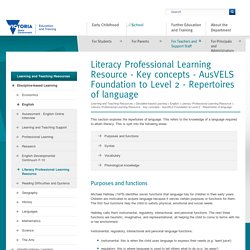
This refers to the knowledge of a language required to attain literacy. This is split into the following areas: Purposes and functions Michael Halliday (1975) identifies seven functions that language has for children in their early years. Children are motivated to acquire language because it serves certain purposes or functions for them. Halliday calls them instrumental, regulatory, interactional, and personal functions. Instrumental, regulatory, interactional and personal language functions: Regs-6-RS-Six-Domains.pdf.
Language Development Domain - Child Development. California Infant/Toddler Learning & Development Foundations.
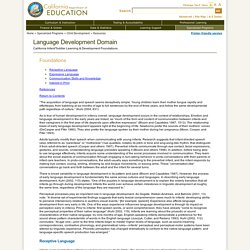
Foundations References Return to Contents “The acquisition of language and speech seems deceptively simple. Young children learn their mother tongue rapidly and effortlessly, from babbling at six months of age to full sentences by the end of three years, and follow the same developmental path regardless of culture.” Beyond the Language Classroom. AcknowledgementsNotes on ContributorsIntroduction; P.Benson & H.ReindersLanguage Learning and Teaching Beyond the Classroom: An Introduction to the Field; P.BensonFamily, Friends and Language Learning Beyond the Classroom: Social Networks and Social Capital in Language Learning; D.PalfreymanPlaces for Learning: Technology-Mediated Language Learning Practices Beyond the Classroom; L.KuureFrom Milk Cartons to English Roommates: Context and Agency in L2 Learning Beyond the Classroom; P.Kalaja, R.Alanen, Å.Palviainen & H.DufvaAffordances for Language Learning Beyond the Classroom; V.MenezesBecoming Multilingual: An Ethnographic Approach to SLA Beyond the Classroom; D.DivitaTalk About Language Use: I Know a Little About Your Language; E.ZimmermanA Possible Path to Progress: Out-Of-School English Language Learners in Sweden; P.SundqvistTeenagers Learning Languages Out of School: What, Why and How Do They Learn?
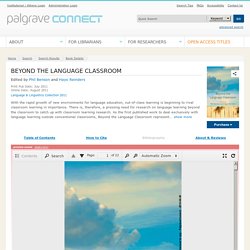
How Can School Help Them? Infomation about the author(s) Close. Literal Comprehension Strategies.
Social-Media Assisted Language Learning. Polyglottally Multilingual Planning & Design. Plurilingualism is the concept promoted by the Council of Europe in its Common European Framework of Reference for Languages (CEFR for short).
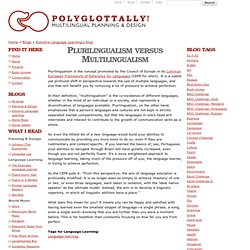
It is a subtle yet profound shift in perspective towards the use of multiple languages, and one that will benefit you by removing a lot of pressure to achieve perfection. In their definition, "multilingualism" is the co-existence of different languages, whether in the mind of an individual or a society, and represents a diversification of languages available. Plurilingualism, on the other hand, emphasizes that a person's languages and cultures are not kept in strictly separated mental compartments, but that the languages in one's head will interrelate and interact to contribute to the growth of communication skills as a whole.
So even the littlest bit of a new language would build your abilities to communicate by providing you more tools to do so, even if they are rudimentary and context-specific. What does this mean for you? Registro Nazionale Formatori Professionisti. Memletics draws together much of what we know about effective learning into an easy-to-apply system.
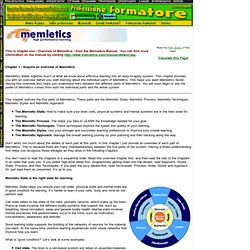
This chapter provides you with an overview before you start learning about the individual parts of Memletics. This helps you learn Memletics faster. Having this overview also helps you understand links between the different parts of Memletics. You will soon begin to see the power of Memletics comes from both the individual parts and the whole system. VYGOTSKY'S DEVELOPMENTAL THEORY: AN INTRODUCTION ( DAVIDSON FILMS ) Principles of Instructed Second Language Acquisition. Download a PDF of this digest.

Second language acquisition (SLA) researchers do not agree how instruction can best facilitate language learning. Given this lack of consensus, it might be thought unwise to attempt to formulate a set of general principles for instructed language acquisition. However, if SLA is to offer teachers guidance, there is a need to proffer advice, providing that it is offered in the spirit of what Stenhouse (1975) called “provisional specifications.” The principles described in this digest, therefore, are intended to provide teachers with a basis for argument and for reflection and not as a set of prescriptions or proscriptions about how to teach.
StephenKrashenscomprehensibleinput.flv. Roger Brown's 14 Grammatical Morphemes flashcards. Michael Halliday. Michael Alexander Kirkwood Halliday (often M.A.K.
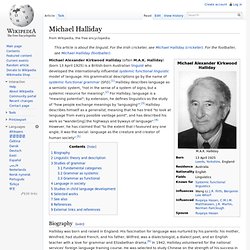
Halliday) (born 13 April 1925) is a British-born Australian linguist who developed the internationally influential systemic functional linguistic model of language. His grammatical descriptions go by the name of systemic functional grammar (SFG).[1] Halliday describes language as a semiotic system, "not in the sense of a system of signs, but a systemic resource for meaning".[2] For Halliday, language is a "meaning potential"; by extension, he defines linguistics as the study of "how people exchange meanings by 'languaging'".[3] Halliday describes himself as a generalist, meaning that he has tried "to look at language from every possible vantage point", and has described his work as "wander[ing] the highways and byways of language".[4] However, he has claimed that "to the extent that I favoured any one angle, it was the social: language as the creature and creator of human society".[5] Biography[edit]
Creating Strong Schools and Communities. Web.pdx.edu/~wubbold/Amazon/readings/Overview of Second Language Acquisition Theory.pdf. Www.ecml.at/LinkClick.aspx?fileticket=/oW/wPuvuWs= EFL methodology. Doing It Differently: Tips for Teaching Vocabulary. Every Monday my seventh grade English teacher would have us copy a list of 25 words she'd written on the board.

We'd then look up the dictionary definitions and copy those down. For homework, we'd re-write each word seven times. Good, now you know it. Test on Friday and never for those 25 words to be seen again. Poof. Copying definitions from the dictionary we would probably all agree is not an effective way to learn vocabulary. The truth is, and the research shows, students need multiple and various exposures to a word before they fully understand that word and can apply it.
Selecting Words Ah, so many words, so little time. My first year teaching, before my tenth graders began reading Lord of the Flies, I went through every chapter and made lists of all the vocabulary words I thought they'd have trouble with, so that I could pre-teach them. When I looked at those long lists, I began to freak out. Then, here's what to do after the students pick their own words: Ranking Words Teaching Words.
Glossary of linguistic terms. Brain-Based Learning: Resource Roundup. Edutopia's list of resources, articles, videos, and links for exploring the connection between education and neuroscience.

(Updated: 12/2013) Building Brain Literacy in Elementary Students, By Judy Willis, M.D. (2013) Neurologist, teacher, author and Edutopia blogger Willis discusses the benefits of teaching elementary students how their brains work. Brains, Brains, Brains! How the Mind of a Middle Schooler Works, by Heather Wolpert-Gawron (2013) Blogger Wolpert-Gawron launches this three-part series by advising middle school teachers to read up on brain research with insight on how the 'tween brain works. In her second blog, The Mind of a Middle Schooler: How Brains Learn, read about important brain terminology and a typical classroom scenario where a middle schooler's brain is hard at work. Stephen Krashen on Language Acquisition.